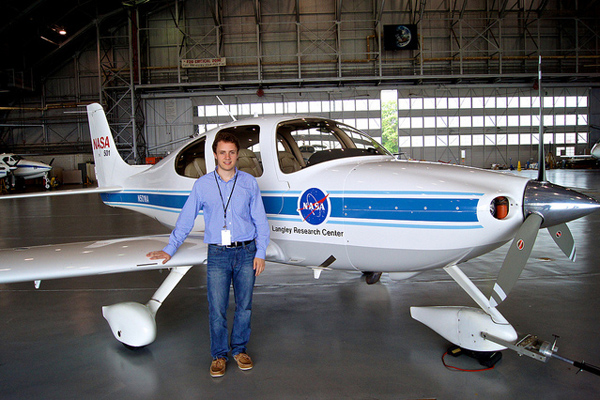Guest Post: Inside the NASA Langley Research Center

This is a guest blog post by Craig Schmidt, a fourth-year undergraduate student in the College of Engineering and recipient of the prestigious Vertical Flight Foundation Scholarship. This summer he’s participating in a unique internship program at the NASA Langley Research Center in Hampton, Virginia.
Preparing a military helicopter for a crash test is a strange experience. You spend three months designing equipment, fabricating parts and preparing instrumentation, only to crash it all into the ground at 40 miles per hour. The physical products of the effort are a set of high speed videos, crash impulse data and a destroyed heap of metal and glass. The practical implications of the test, however, are more substantial. Inside the airframe lie three innovative energy absorbers, designed by NASA and the U.S. Army. Made of composite materials, these energy absorbers are designed to cushion passengers from hard impacts and decrease the likelihood of injury.
For me, working at a NASA research facility came with a certain expectation: scientists in white coats, rockets and top secret projects that no one can talk about. As I finish my seventh week, I’ve realized most of my assumptions were dead wrong. The office is full of casual discussions and the occasional overhead “buzz” of an F-22 Raptor coming in for landing at Langley Air Force Base. I was most surprised at how accessible the labs and research projects were, especially for summer students. My first week, I heard rumors that a scale model of the Mars SLS (Space Launch System) rocket would be tested in a supersonic wind tunnel. Amazingly, when I asked my supervisor is this was true, he nonchalantly said, “Yea, do you want to watch?” NASA Langley’s campus is an interactive aeronautics exhibit. Wind tunnels line the main road, helicopters and jets circle the skies around the air force base and people walk the sidewalks with flight hardware in hand.
The research philosophy is consistently, “Play around with it,” or “Figure it out.” While this is a daunting idea at first, it is in large part responsible for NASA’s culture of innovation and exploration. Discoveries are often made that would have been out of the scope of a traditional task. Researchers are especially quick to incorporate students in their projects. Interns can consistently be seen shuffling to and from labs, sometimes in disbelief of the technology they just witnessed.
The past seven weeks has been more than an internship, it has been the full NASA experience. The true value of working at Langley lies in meeting people and learning about the history of the center. I’ve learned to ask everyone I meet, “What was it like working on that project?”, and listening to whatever is on their mind.
Such an experience reinforces the notion of continuous education. From start to end, students are exposed to not only finished technology, but the know-how and mindset necessary to become a pioneer and innovator in a technically demanding field. Ten weeks well spent.




